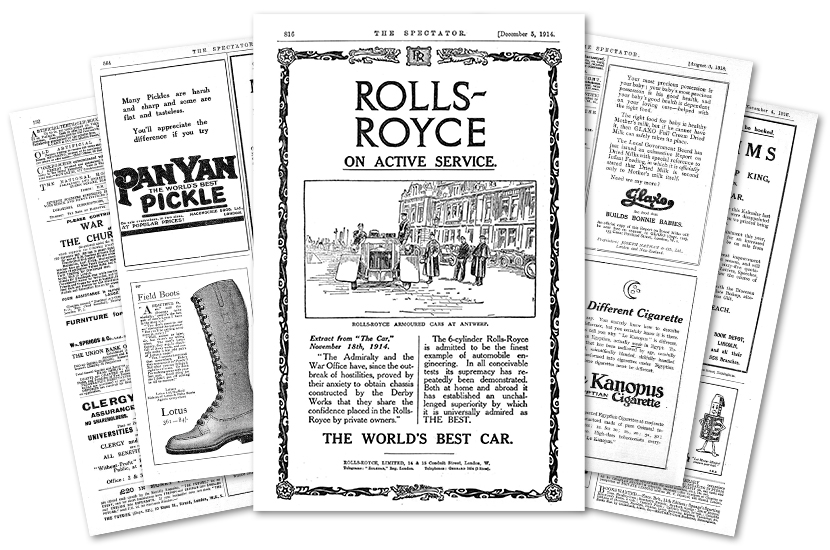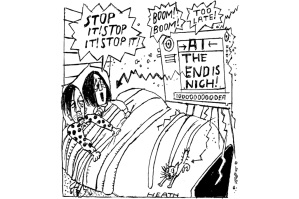A conventional hierarchy of print media would put serious journalism at the top. Far beneath that would be tabloid journalism. And then at the very bottom would be advertising.
Except, in one respect, I think that order should be reversed. Yesterday’s advertising is much more interesting than yesterday’s serious journalism.
I suspect this is because advertising, like tabloid journalism, reflects what people really care about — and always have done. Gossip. Sex. How to attract the opposite gender. What car to buy. Health complaints. Miracle cures. Death. Money. The Beckhams. The Windsors. The new 55in QLED 4K television. At last relief from embarrassing itching. Love Island’s Kaz Crossley displays her jaw-dropping figure in a black bikini as she dances in a shower while in Thailand. How else can a month’s salary last a lifetime?
Advertising and tabloid journalism — they’re the real thing. They are what everyone is truly interested in. Serious journalism, by contrast, covers what a small, self-appointed elite pretend to be interested in so as to appear sophisticated and au courant to each other. It’s often a duty read, done to avoid the fear of looking ill-informed.
Thomas Sowell once said that ‘Political activism is a way for useless people to feel important’. The same could be said for reading commentary on current affairs. Because when you look back across the sands of time, though two percent of what is debated turns out to be of immense importance, the majority turns out to be astoundingly irrelevant. And it’s impossible to tell at the time which is the two percent that actually matters. In the wider scheme of things, it is quite likely that Brexit turns out to be as irrelevant as the ground-nuts scandal, despite the gallons of ink spilled over it; by contrast the really game-changing stuff — such as admitting China to the World Health Organization — barely aroused any comment at the time.
In terms of evolutionary psychology, serious journalism is tomorrow’s fish-and-chip paper, whereas advertising, like tabloid journalism, is as eternally relevant as the works of Shakespeare.
To commemorate the 10,000th edition of The Spectator, I looked at a cross-section of advertisements from 1828 to the present day. And whereas I suspect the accompanying content is mostly of interest only to historians of the Corn Laws and so forth, the advertising is endlessly fascinating.
How little changes! It was announced recently that McLaren and other Formula 1 companies are helping with the design of ventilators for the National Health Service. In 1914 it was Rolls-Royce advertising its contribution to the war effort. ‘The Admiralty and the War Office have, since the outbreak of hostilities, proved by their anxiety to obtain chassis constructed by the Derby Works that they share the confidence placed in the Rolls-Royce by private owners.’
I can imagine the copywriters back in 1914 having the same conversations we are having (by videolink) now. What do we do to respond to this crisis and avoid making our advertising look irrelevant? So: ‘No rise in the price of Lotus shoes — same now as before the war.’ (I think that is the maker of the Lotus Veldtschoen shoe, of which I still have a pair inherited from a great uncle; they still polish up a treat.) By 1916 Lotus were advertising field boots.
Some things are different. Glaxo — which today is the G of GSK, a FTSE company and the sixth largest pharmaceutical company in the world — advertises frequently, but with the slogan ‘Glaxo builds bonnie babies’. There is an obsession with knock-off imitations in the copy which you don’t see today. Lea & Perrins is particularly insistent that you ask for the product by its full name, a problem of the age before supermarkets when you would ask for ‘Worcester Sauce’ and the grocer would fob you off with his feeble imitation. There are other surprises too.
In my working life, I doubt I shall ever have the opportunity to end an ad with the sentence ‘charms away the feeling of fatigue, gives stamina, and convinces you that the end of the British Empire is not yet — not yet’. Nor will I ever be able to use a clergyman to promote tobacco, which ‘soothes the restless soul in a riotous age’. Nor advertise the virtues of moving to British Columbia on the grounds that ‘74 percent of the population is of British origin’. I was surprised to see an ad for Madras Curry Paste from the early 19th century (our obsession with Indian food is older than I thought) and one for a newly published book by Jeremy Bentham (one shilling).
Hovis, Horlicks and Carr’s biscuits are there. Bovril, Boots, Colman’s, Fortnum’s, Cross & Blackwell (at the time a shop, not a manufacturer), Cadbury, Fry’s and a host of life-assurance companies which you would still recognize. But the most remarkable advertisement is an ad for The Spectator itself, from 1829, when it was one year old.
‘The tone and character of “THE SPECTATOR”, the variety of its contents, and even its external form, peculiarly fit it for the Use of respectable Families. Its Plan is entirely new, comprising:
1. The whole NEWS OF THE WEEK, so selected, sifted, condensed and arranged, as to be readable throughout.
2. A full and partial exhibition of all the leading POLITICS of the day.
3. A separate discussion of INTERESTING TOPICS of a general nature, with a view to Instruction and Entertainment at the same time.
4. A Department devoted to LITERATURE, consisting of Independent Criticisms on New Books, with Specimens of the best passages.
5. DRAMATIC and MUSICAL criticism.
6. SCIENTIFICAL and Miscellaneous Information.
This Newspaper is especially recommended to the notice of English Families resident on the Continent.’
This is more or less an exact description of the magazine 9,950 issues later. (I like to think of the Wiki Man as an occasional purveyor of SCIENTIFICAL and Miscellaneous Information.)
What a perfect example of how the greatest brands endure unchanged. Like Lea & Perrins, when you have a winning formula, you shouldn’t change a thing.
This article was originally published in the
The Spectator’s 10,000th UK magazine. Subscribe to the US edition here.


















